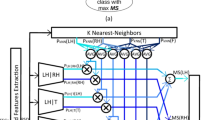Abstract
An important problem of machine vision is the balance among the efficiency, accuracy and computation cost. The visual system of man can keep watchfulness to the perimeter of a visual field and subtly process information emerging in the center of the visual field at the same time. This kind of requirement assignment of computation can virtually ease the demand of hardware both in quantity and complexity. Therefore designing an artificial model based on biological mechanism is an effective approach. In this paper a multi-layer neural model is designed based on the multi-scale receptive fields of ganglions in retina. The model can keep watch on the periphery part of a scene while processing the center information of the scene. And why it can balance the hardware complexity, processing precision and computational intensity is analyzed. An experiment is done to test the model's sensitivity in watchfulness keeping and its efficiency and veracity in environment sampling. This model may provide valuable inspiration in the implementation of real-time processing and the avoidance of expensive computation cost in machine vision.
Access this article
We’re sorry, something doesn't seem to be working properly.
Please try refreshing the page. If that doesn't work, please contact support so we can address the problem.
Similar content being viewed by others
References
Erten G, Salam F. Real-time realization of early visual perception. Int. Journal of Computers and Electrical Engineering, Special Issue on Micro-Electronic Hardware Implementation of Soft Computing: Neural and Fuzzy Networks with Learning, 1999, 4(2/3), 379–407.
Conklin C, Watkins R, Foo S et al. Dichromatic color perception: A fast alternative for machine vision systems. Engineering Applications of Artificial Intelligence, 2002, 15(5): 351–355.
David K Andes, James C Witham, Michael D Miles. MAVIS: A special purpose neural computational system for ATR. Neural Networks, 1995, 8(7/8): 1349–1358.
Ito Y, Yagi T, Kanda H et al. Cultures of neurons on micro-electrode array in hybrid retinal implant. In Proc. 1999 IEEE Int. Conf. Systems, Man and Cybernetics, IV, Tokyo, Japan, 1999, pp.414–417.
Resatz S, Rattay F. Excitability of bipolar and ganglion cells with retinal prosthesis: A modeling study. Engineering in Medicine and Biology Society 2003. In Proc. the 25th Annual Int. Conf. the IEEE, Cancum, Mexico, Sept. 17–21, 2003, Vol.3, pp.2039–2042.
Prhahg F, Piittjer D, BuB R et al. Intraocular vision aid (IOS): Optical signal transmission and image generation. In Proc. the 22nd Annual Int. Conf. the IEEE, Engineering in Medicine and Biology Society, Chicago, USA, July 23–28, 2000, Vol.1, pp.796–797.
Ela Claridge, Ian R Billups. Towards a method for parameterizing models of early vision using psychophysical data. Image and Vision Computing, 1998, 16(6/7): 473–498.
Nader M Nofal, Hazem H Ali, M E Zaghloul. A CMOS visual system using CRM. In IEEE Proc. 1998 Midwest Symposium on Systems and Circuits, South Bend, Indiana, August 9–12, 1998, pp.552–555.
Markus Schwarz, Ralf Hauschild, Bedrich J Hosticka et al. Single-chip CMOS image sensors for a retina implant system. IEEE Trans. Circuits and Systemsp–II: Analog and Digital Signal Processing, 1999, 46(7): 870–877.
Chiang C-T, Wu C-Y. Implantable neuromorphic vision chips. Electronic Letters, 2004, 40(6): 478–479.
Kareem A Zaghloul, Kwabena Boahen. Optic nerve signals in a neuromorphic chip II: Testing and results. IEEE Trans. Biomedical Engineering, 2004, 51(4): 667–675.
Thomas Stieglitz, Hansjoerg Beutel, Ralf Keller et al. Integrative design and hybrid assembly of a flexible retina implant system. In Proc. the First Joint BMES & EMBS Conference Serving Humanity, Advancing Technology, Atlanta, GA, USA, Oct. 13–16, 1999, p.474.
Rolf Eckmiller, Michael Becker, Ralph Hunermann. Towards a learning retina implant with epiretinal contacts. In Proc. the IEEE Int. Conf. Systems, Man and Cybernetics, Tokyo, Japan, 1999, Vol.4, pp.12–15.
Ales Leonardis, Horst Bischof. Kernel and subspace methods for computer vision. Pattern Recognition, 2003, 36(9): 1925–1927.
Murino V, Vernazza G. Artificial neural networks for image analysis and computer vision. Image and Vision Computing, 2001, 19: 583–584.
Fleet D J. The early processing of spatio-temporal visual information [Thesis]. University of Toronto, Sept. 1984.
William R Hendee, Peter N T Wells. The Perception of Visual Information. Springer-Verlag, New York, Inc., 1997.
Wills D S, Baker J M, Cat H H et al. Processing architectures for smart pixel systems. IEEE Journal of Selected Topics in Quantum Electronics, 1996, 2(1): 24–34.
Author information
Authors and Affiliations
Corresponding author
Additional information
This research is supported by the NSFC under Grant No.60303007, the National Basic Research 973 Program of China under Grant No.2001CB309401, and the open project of Key Laboratory of Intelligent Information Processing, ICT of CAS under Grant No.IIP2002-3.
Rights and permissions
About this article
Cite this article
Wei, H., Luan, SM. Ganglion-Based Balance Design of Multi-Layer Model and Its Watchfulness-Keeping. J Comput Sci Technol 20, 567–573 (2005). https://doi.org/10.1007/s11390-005-0567-2
Received:
Revised:
Issue Date:
DOI: https://doi.org/10.1007/s11390-005-0567-2




